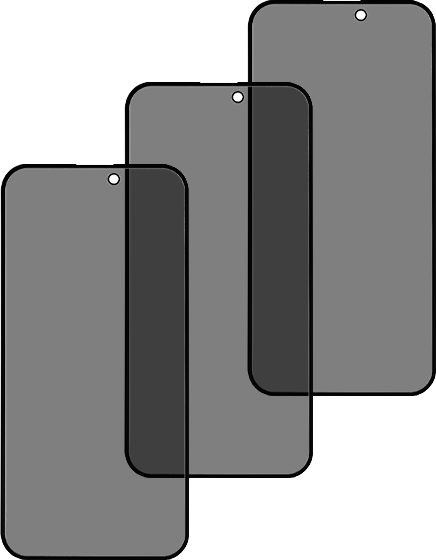— Engineering Differences Between 2.5D / 3D / 9D, Privacy Glass, and Camera Lens Protectors

At first glance, screen protectors all seem similar, but in fact, they differ greatly in structure, manufacturing process, curved surface shape, and optical treatment.
This guide breaks down the engineering behind NCC’s tempered glass series—2.5D, 3D, 9D, privacy protection, and camera lens protectors—to help users understand how each type performs and why each is designed the way it is.
1. Understanding Edge Geometry: 2.5D vs. 3D vs. 9D
The “D” scale refers to the profile of the glass edge—its contour, polishing depth, and compatibility with curved screens.
1.1 NCC 2.5D High Definition Tempered Glass
— Flat Structure With Polished Arc Edges
Manufacturing Profile:
- Flat glass substrate
- CNC edge grinding to create a micro-arc 2.5D contour
- Smooth transition between glass surface and edges
Technical Advantages:
- Highly case-friendly due to minimal curvature
- Reduced stress concentration during impact
- Lower risk of peeling caused by tight phone cases
- High optical clarity due to flat construction

Recommended for:
Users who prefer a stable, traditional tempered glass with reliable durability and full touch accuracy.
1.2 NCC 3D High Definition Tempered Glass
— Curved Glass Formed to Match the Phone Screen
Manufacturing Profile:
- Heated and formed glass that follows the phone’s curved edge
- Matching the OEM screen radius (R-angle)
- Full-screen arc coverage
Technical Advantages:
- Better edge sealing reduces dust infiltration
- Seamless touch feel from center to edge
- Improved aesthetics due to continuous curvature
- Precise alignment for modern curved-edge iPhones

Recommended for:
Users needing complete edge-to-edge coverage with a near-OEM look and feel.
1.3 NCC 9D Curved Edge Tempered Glass
— Reinforced Edge Architecture
Compared with 3D, 9D incorporates a stronger structural design.
Engineering Enhancements:
- Thickened frame
- Multi-step polishing further enhances the edge toughness
- The corner of the screen has higher impact resistance
Technical Advantages:
- Enhanced anti-breakage performance
- The anti-fracture ability has been enhanced
- It is safer and more suitable for users who often drop their phones

Recommended for:
It is suitable for users who consider screen edge protection and the durability of tempered films over the simple appearance of their phones.
2. NCC Privacy Tempered Glass
— Optical Shielding Based on Directional Filtering
NCC Privacy Glass uses microlouver privacy filtering, the same principle used in ATM screens and office privacy panels.
Technical Mechanism:
- A privacy film layer is embedded beneath the tempered glass
- The layer restricts light transmission to a 28° viewing angle
- Outside the permitted angle, brightness drops to block visibility
Performance Benefits:
- 152° anti-peeping coverage
- Protects sensitive content from side viewing
- No interference with touch response or Face ID
- Maintains high-definition clarity from the front view
Available in:
- 3D Privacy Glass
- 9D Privacy Glass

Recommended for:
Professionals, commuters, and anyone who regularly uses their phone in public spaces.
3. NCC Camera Lens Protectors
— Optical Transmittance Meets Structural Safety
The camera system requires a different protection approach from the main display.

3.1 Tempered Glass Lens Protectors
Technical Specs:
- High-transmittance glass (>93%)
- Multi-layer coating for fingerprint and oil resistance
- Precision cutouts for individual or full-module coverage

3.2 Aluminum Alloy Single Lens Protectors
Engineering Advantages:
- Anodized aluminum alloy frames
- CD-texture machining improves surface hardness
- HD lens protection without distortion
- Designed for impact resistance around camera edges
Recommended for:
Users who want added camera durability while preserving photo clarity and the original style of the phone’s camera module.
4. Material Standards Across NCC Screen Protectors
Regardless of model type, all NCC protectors follow consistent material and production standards:
Glass and Coating Technology
- 9H Hardness Tempered Glass
- High Light Transmission Rate
- Oil-Repellent Nano-Coating
- Anti-static Treatment for Easy Cleaning and Installation
- Full Adhesive Layer for Stable Touch Sensitivity
Precision Engineering
- CNC Machining
- Multi-step Polishing for Smooth Edges
- Seamless Bonding Technology
- Precise Alignment for Close Model Replication
5. Choosing the Right Protector: Technical Recommendations
Requirement — Recommended NCC Product
- Case compatibility — 2.5D HD Glass
- Full curved coverage — 3D HD Glass
- Strong edge durability — 9D HD Glass
- Privacy filtering — 3D / 9D Privacy Glass
Camera protection — Tempered Lens Protector / CD-Pattern Single Lens
Final Thoughts
Understanding screen protector engineering helps users choose more confidently.
NCC has always focused on making practical, dependable digital accessories that fit naturally into people’s daily lives. As our product range grows, we remain committed to good quality, thoughtful design, and long-term value for our partners and users.
If you’d like to learn more about our products or check the latest quotation list, you’re welcome to reach out to us anytime. We’re here to help.
